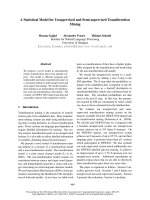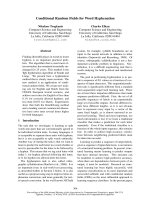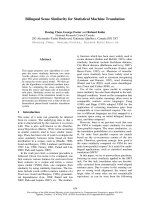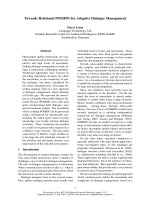Báo cáo "Design dual band microstrip antenna for RFID application" potx
Bạn đang xem bản rút gọn của tài liệu. Xem và tải ngay bản đầy đủ của tài liệu tại đây (105.93 KB, 5 trang )
VNU Journal of Science, Natural Sciences and Technology 26 (2010) 276-280
276
Design dual band microstrip antenna for RFID application
Tran Minh Tuan
National Institute of Information and Communications Strategy, 115 Tran Duy Hung, Hanoi, Vietnam
Nhận ngày 19 tháng 3 năm 2010
Abstract. The research, simulation and design dual band antenna which operates at 900MHz and
2.45GHz are conducted. FR4-epoxy substrate is chosen with thickness h = 1.5mm, ε
r
= 4.4. Dual
band can be achieved by using different methods of impedance’s matching for single antenna
which is originally designed at 900MHz. Some dual band RFID structures are discussed in this
paper.
Keywords: dual band antenna, RFID antenna, impedance matching.
1. Introduction
∗
It is not new concept, however recent years,
Radio Frequency Identification (RFID) is used
widely. Nowadays, RFID usually operates at
125 kHz - 135 kHz (LF), 13.56MHz (HF),
420MHz - 460MHz, 860MHz - 960MHz
(UHF), 2.45GHz, 5.8GHz (ISM) [1-4].
However depending on the using purposes,
some applications need small structure, others
require multipurpose tags or tags can be used in
different environments. Therefore reduction
size of antenna and combination multi antennas
are requested [5].
In this aspect, dual band antennas are one of
the best solutions. The combination of
frequencies usually is between 900MHz and
2.45GHz or 13.56MHz and 900MHz. In fact, so
far many structures have been studied. For
example, designing two antennas on the same
_______
∗
Tel.: 84-4-35565043.
E-mail:
substrate or using a rectangular patch or H-
shape patch with coaxial feeder and shorting
pin. Other structures like slot antennas with L –
shape or U – shape structures can be used too.
In this paper, we propose new approach to
achieve dual band from single antenna by
matching impedance method. We chose dual
antenna which operate at 900MHz and
2.45GHz to design, simulate and manufacture.
2. Design and simulation
It should be noted that any antenna always
has more than one resonant frequency. It
depends on feeder or matching impedance.
Normally, it is not difficult to find first resonant
frequency. As a dipole, with length of arm
approximates λ/2, we can consider first
resonant frequency [6]. The applications only
use one frequency on tags usually ignore other
positions.
T.M. Tuan / VNU Journal of Science, Natural Sciences and Technology 26 (2010) 276-280
277
But in this paper we want to have good
second resonant frequency by this theory. We
will begin with an antenna which operates at
900MHz, then using matching impedance to
find second resonant frequency 2.45GHz.
Although we add stubs on original antenna can
reduce or change position of first frequency, but
we can control this change by adjust position,
size step by step very carefully, sometime we
need to adjust a little width of elements of
original design.
This paper examines two types of
impedance matching. One uses stub to match
impedance, while other one matches impedance
by slots. All of design use substrate of FR-4
epoxy with thickness 1.5mm, ε = 4.4.
In first type of matching, we examine two
kinds of antenna. The first one is showed Fig. 1.
Fig 1.
Fig 2.
We started antenna operate at 900MHz
which is designed as rectangular meander with
microstrip line 50Ω. The length and width of
antenna is calculated by Ansoft Designer.
Detail size of this antenna: Width: w1 = w2 =
w3 = w4 = 4mm; Length: d0 = 25 mm, d1 = 16
mm, d2 = 28mm, d3 = 31mm, d4 = 25mm, d5 =
13mm; Stub has width ws = 4mm and length ds
= 13mm.
Ground plane coincides with bottom side,
width and length of ground plane wg, dg equal
8 mm, 50 mm respectively. Result of simulation
is plotted at Fig. 2.
Figure 2 is a result of simulation for two
above cases. When antenna has not stubs (red
line), it only operate well at 900MHz, while at
2.45GHz, S11 value is worsen. When the stubs
are added, at 900MHz, there is a litter change of
S11 values, while at 2.45GHz, it is strongly
better.
Second of type matching: matching by slot.
Continuously using rectangular meander
antenna. We keep bottom side, add rectangular
patch into center antenna on top side. Distance
between each edge of patch and antenna is
adjusted to match impedance. In the paper, this
distance is 1mm. Then we add an L-shape slot
into center rectangular patch. Now our antenna
has shape as figure 5. It looks like an o’clock.
Fortunately, when we change position, size,
angle of “hands of o’clock”, we can match
impedance better.
Fig 3.
T.M. Tuan / VNU Journal of Science, Natural Sciences and Technology 26 (2010) 276-280
278
Fig. 4. Size of L – slot.
The size of this design: w1 = w3 = 4mm,
w2=w4 =5mm, d1 = 18mm, d2 = 33mm, d3 =
31mm, d4 = 29mm, width of microstrip line wf
= 3 mm, df = 8mm. Ground plane on bottom
side with wg = 8mm, dg = 50mm. Distance d
between feed point to edge of ground plane is d
= 25mm. Rectangular patch has size 19mm x 23
mm, width of slots is 1 mm.
We also check some other shapes of “hands
of o’clock” too. Fig. 5 shows two antennas
which are similar to antenna at Fig. 3 and have
different rectangular patch. Results are
compared at Fig. 6.
Fig 5.
Fig 6.
Dash line as result of simulation antenna at
Figure 4, solid line is result of antenna at
Figure. 5 (a) and result of antenna at Figure 5(b)
is remains.
At this type, when using rectangular patch
not only give good result at frequency 2.45GHz
but also improving matching impedance at
900MHz.
3. Measurement result
Measurement results are analyzed by
Network Analyzer. S11 parameter was
displayed and compared with simulation. We
also consider radiation pattern at 900MHz and
2.45GHz.
For the first design. (The design uses stub).
Fig. 7. S11 parameter.
T.M. Tuan / VNU Journal of Science, Natural Sciences and Technology 26 (2010) 276-280
279
Fig. 8. Radiation pattern at 900MHz.
Fig. 9. Radiation pattern at 2.45GHz.
For the second design (The design uses
slots).
Fig. 10. S11 parameter.
Fig. 11. Radiation pattern at 900MHz.
Fig. 12. Radiation pattern at 2.45GHz.
T.M. Tuan / VNU Journal of Science, Natural Sciences and Technology 26 (2010) 276-280
280
Measurement result is as good as we expect
at position of resonant frequency. Although,
S11 values are different. With antenna’s S11
value usually equals -8dB to -10dB, it means
SWR is smaller 2.5, all result of simulation or
measurement are close -20dB to -30dB. So
these results are in good agreement. Another
problem, bandwidth is not quite large. At both
900MHz and 2.45GHz under level of -10dB,
measured bandwidth is above 100MHz (100 ÷
150M), while in simulation at 2.45GHz it is
bigger (about 440MHz). However, it should be
noted that RFID systems usually operate with
small bandwidth as 100MHz bandwidth at
900MHz frequency (860MHz – 960MHz). For
this reasons, we can accept this results. Another
issue is that at 2.4GHz measurement result is
deeper than simulation one, while the
bandwidth of measurement result is worse than
simulation one. The reason is that the real FR-4
permeability is not exact as in theory (ε = 4.4)
and the prototype is not well manufactured.
4. Conclusion
This design is quite simple and not difficult
to perform. Measurement result is a litter bit
difference than simulation one. But the
structure has small dimension and therefore it is
found wide application in reality.
Acknowledgements
This work is supported in part by Korea
advanced institute of science and technology –
Information Communications College (KAIST
ICC) of Korea.
References
[1] Mikko Keskilammi, Markku Kivikoski, Using
text as a meander line for RFID transponder
antennas.
[2] Leena Ukkonen, Lauri Sydänheimo, Markku
Kivikoski, Effects of metallic plate size on the
performmance of microstrip patch-type tag
antennas for passive RFID, IEEE, vol4 (2005)
[3] Woosung Lee, Kihun Chang, Young Joong
Yoon, Small RFID tag antenna with bandwidth-
enhanced characteristic.
[4] Seunggil Jeon, Yeonsik Yu, Sungtek Kahng,
Juderk Park, NaeSoo Kim, Jaehoon Choi, Dual-
band Dipole antenna for ISO 18000-9/ISO
18000-4 passive RFID tag application.
[5] David M Pozar, Microwave Engineering, John
Willey & Son, INC, Second Edition.
[6] Prof. Phan Anh, Antenna Theory and Technique,
Science and Technical Press, Ha Noi, 2000.
Thiết kế anten mạch dải đa băng cho ứng dụng RFID
Trần Minh Tuấn
Viện Chiến lược Thông tin và Truyền thông, Bộ Thông tin và Truyền thông,
115 Trần Duy Hưng, Hà Nội, Việt Nam
Nghiên cứu, thiết kế và mô phỏng anten đa băng hoạt động ở băng tần 900 MHz và 2.45 GHz.
Anten được thiết kế trên tấm FR-4 với độ dày 1.5mm và hằng số điện môi là 4.4. Đa băng có thể được
tạo nên nhờ việc sử dụng các phương thức phối hợp trở kháng khác nhau của các anten đơn ban đầu
được thiết kế ở tần số 900 MHz. Một vài cấu trúc anten đa băng RFID sẽ được đưa ra thảo luận trong
bài báo này.









